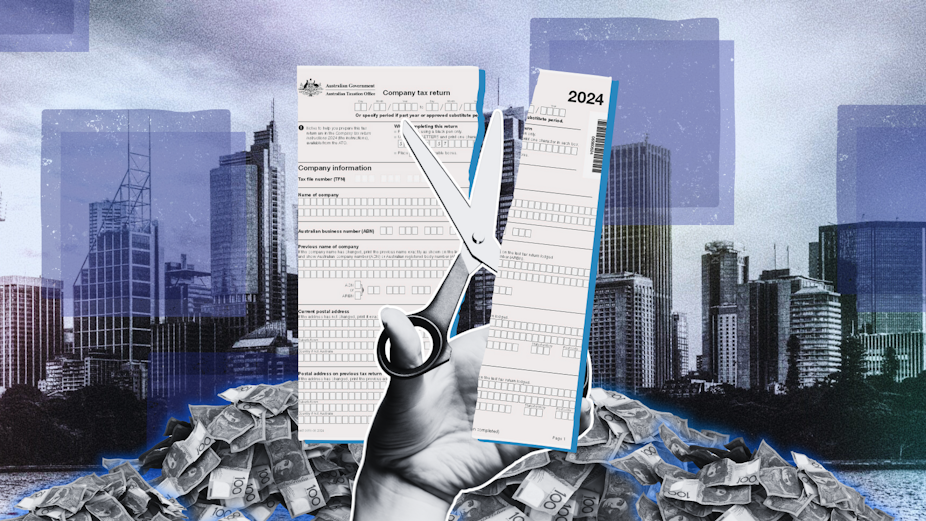Would a corporate tax cut boost productivity in Australia?

Productivity is essentially the art of earning more while working less and is critical for driving our standard of living higher.
The Productivity Commission, tasked with figuring out how to get Australia’s sluggish productivity back on track, is pushing hard for corporate tax cuts as a key part of their plan for building a “dynamic and resilient economy”.
The idea? Lower taxes will attract more foreign investment, get businesses spending again and eventually boost workers’ productivity.
Commission chair, Danielle Wood, said last week while the commission wanted to create more investment opportunities, it was aware this would hit the budget bottom line:
So we’re looking at ways to spur investment while finding other ways we might be able to pick up revenue in the system.
The general company tax rate is currently 30% for large firms, and there’s a reduced rate of 25% for smaller companies with an overall turnover of less than A$50 million.
What the textbooks and other countries tell us
The Productivity Commission’s theory makes sense: if you make capital cheaper and you should get more of it flowing in.
A larger stock of capital means there is more to invest in Australian workers. This should make us more productive and help boost workers’ wages. And looking overseas, the evidence mostly backs this up.
A meta-analysis of 25 studies covering the US, UK, Japan, France, Germany, Canada, Netherlands, Sweden, Italy, Switzerland, Denmark, Portugal and Finland found every percentage point you slice off the corporate tax rate brings in about 3.3% more foreign direct investment.
Other research shows multinational companies really do move their operations to places with lower tax rates. This explains why we’re seeing this race to the bottom across Europe and North America, with countries constantly trying to undercut each other.
Research on location decisions shows how multinationals reshuffle their operations based on effective average tax rates.
Even within the United States, a US study found increases in corporate tax rates lead to big reductions in employment and wage income. However, corporate tax cuts can boost economic activity – though typically only if they are implemented during recessions.
Australia’s limited track record
Here in Australia we don’t have much local evidence to go on, and what we do have is pretty puzzling.
This matters because Australia’s corporate tax system has some unique features that may make overseas evidence less relevant. We have dividend imputation (franking credits), different treatment of capital gains, access to immediate reimbursement for some small business expenses and complex capitalisation rules that limit debt deductions for multinationals.

.A study by a group of Australian National University economists looked at how the tax system affects business investment. They examined the [2015 and 2016 corporate tax cuts] for small businesses using data on business investment from the Australian Bureau of Statistics combined with tax data from the Australian Tax Office.
The findings were mixed. After the 2015 cut, firms already investing in buildings and equipment spent more — that is, the policy boosted investment only at the intensive margin.
By contrast, there was no evidence it enticed firms that had not been investing to start doing so. The follow-up cut in 2016 had even less bite. Its estimated effect on investment was so small it is statistically indistinguishable from zero.
It remains unclear why the previous corporate tax reductions largely failed to produce a measurable increase in investment. Perhaps the tax cut itself was simply too modest. Or the available data was too volatile to capture its effects.
But it runs contrary to what economic theory tells us to expect. This should give us pause for thought.
The big questions nobody can answer yet
For politicians thinking about another round of corporate tax cuts, this creates an uncomfortable situation. We’ve got solid evidence from overseas it works, but only one weak data point from Australia, plus a lot of head-scratching about why the second cut didn’t move the dial.
Fortunately, the Productivity Commission has the in-house expertise to further investigate this question.
Before we make further cuts to the company tax rate, we should have an in-depth study of these two tax cuts replicating and extending the previous work to see what effect – if any – they had on investment, employment, productivity and Australian living standards.
Until we can solve these puzzles, Australia’s debate over corporate tax rates will keep spinning its wheels. Much like our national productivity itself.




